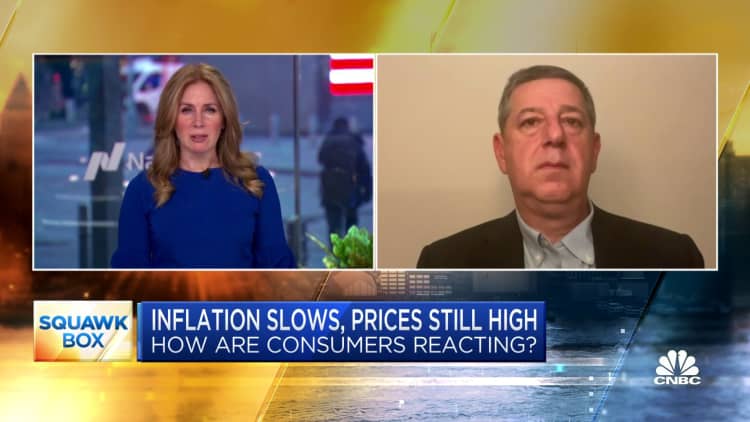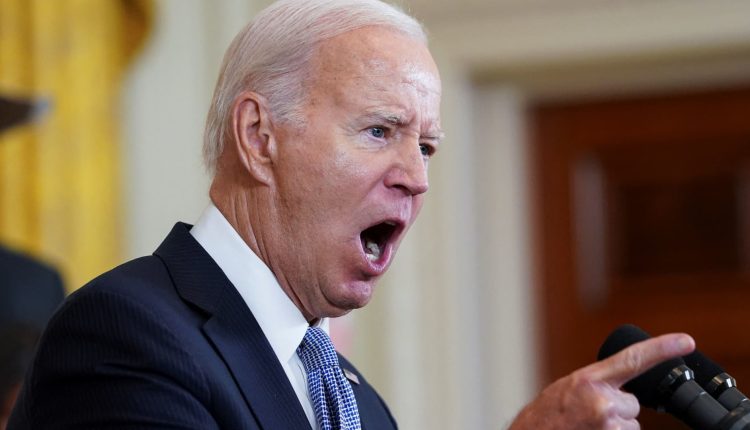U.S. President Joe Biden delivers remarks during an event to celebrate the anniversary of his signing of the 2022 Inflation Reduction Act legislation, in the East Room of the White House in Washington, U.S., August 16, 2023.
Kevin Lamarque | Reuters
In recent weeks, President Joe Biden has been doing everything he can to point the finger at big corporations for high prices.
“Too many things are unaffordable,” the president said.
“Stop the price gouging,” Biden said on another recent occasion.
The blame game may be good retail politics, and the president has announced some real actions to alleviate consumer financial stress, forgiving as much student debt on the margins as he can under the law, unveiling various plans to eliminate “junk fees,” and using new powers under the Inflation Reduction Act to bring down key drug prices.
Some recent research supports the case that corporations have taken more advantage of the current inflationary era than they really need to do. But amid the political pressure, don’t expect corporate America to be swayed.
As the Federal Reserve signals for the first time that it’s getting comfortable with the decline in inflation, and even short of declaring “mission accomplished” seemed to say this week it doesn’t wholly disagree with the market view that rates cuts are the next phase in its monetary policy, the one major force in the economy not talking about cuts in a major way is corporations.
That’s been on the mind of Fed presidents as the central bank contemplates a big shift. Richmond Fed President Tom Barkin, a former corporate sector CFO, recently told CNBC that one area he monitors and speaks to companies about is price setting. Companies won’t be giving up their power to raise prices “until they have to,” Barkin, who will be a voting member of the FOMC next year, said.
It’s been a hard-won advantage. Over the past two decades, price setters “have been beaten up,” Barkin said, by the combination of ecommerce, globalization, access to new supply and the power of big box retailers. “If you go back to 2018-2019, you had people who really weren’t into raising prices [as they] didn’t think they had the power to do it. I’m out there talking to price setters now and there are some who have taken a step back and said, ‘Okay, we’re on the backside of this,’ but I still talk [to others] who are looking to get more price.”
During an interview later in November with Barkin at CNBC’s CFO Council Summit in Washington, D.C., the subject came up again, and an informal poll of CFO Council members in the room on the subject of pricing plans for 2024 was taken. A majority said their companies would be raising prices next year; a minority said they would keep pricing the same; none said they would be lowering prices.
“I’m looking for the point where they’re no longer taking outsized price increases because they’re worried the volume and the market won’t sustain it,” Barkin said.
That is happening in certain goods markets where the Covid outsized demand has waned, and as the pressures in the real estate market with high mortgage rates have cut down on purchases for the home. It’s also a function of a massive freight market recession, which has sharply lowered transportation costs for shippers after a period of huge contract rate increases during the pandemic boom. A recent decline in energy prices has also lessened input cost pressures.
Costco CFO Richard Galanti said after its earnings this week that inflation for the quarter just ended was in the 0% to 1% range. But the big moves were in the “big and bulky items,” like furniture sets due to lower freight costs year-over-year, as well as on “things like domestics,” he said. And what he called the “deflationary items” were steeply down in price, as much as 20% to 30%.
Toys are another example.
No one wants to be the first to cut prices
Overall, though, the economy is not headed for deflation, and the Fed’s stance this week may have given companies more room to keep prices where they want if real wage growth proves sustainable. “Inflation is falling faster than wages,” said KMPG chief economist Diane Swonk. “That does not equate to deflation. The goal is to keep that trend going, so that consumers regain the purchasing power lost to inflation.”
But with any easing of rates, the central bank is “willing to throw the dice, and enable the economy to grow more rapidly rather than risk recession,” Swonk said. “That is a major shift from where we were a year ago. They knew that the decision to call an end to rate hikes would trigger financial markets to ease. That was like a stealth cut in rates. It will stimulate the economy. Improvements in inflation are expected to continue, but the pace at which price increases decelerate could slow.”
The recent tailwinds from a softer freight market may be near their end, too. A logistics CFO speaking on a CNBC CFO Council member call on Tuesday about the market outlook said that after one of the longest stretches in recent history for a freight recession, the trough may have been reached. “Truck rates may start bouncing off of a bottom here,” said the logistics CFO on the call, where chief financial officers are granted anonymity to speak freely.
While the Fed may get its wish of a “soft landing” for the economy, that doesn’t mean prices will land as softly for consumers, according to Marco Bertini, a professor of marketing at business school Esade who studies pricing strategy and pricing psychology. “Companies will do what they want and will never react at the speed you want them to, especially after they have been increasing prices,” Bertini said. “Why would I be the first to cut my margins when we just went through a period where we had the world’s best excuse [inflation] to recover margins?” he said.
At some point, companies will need to reassess pricing strategy, especially with margins more than recovered for many, and this period of rapid inflation in the U.S. doesn’t have a precedent for companies to use as a barometer of how to shift. “It’s uncharted territory for the U.S. market,” Bertini said.
That’s part of the reason why not one CFO raised their hand at the CNBC CFO Council Summit when asked if any were considering a price decrease for 2024.
“Imagine I am the first to say I am holding on prices, and make that known to customers? That’s how a price war starts and the competitive advantage from being the ‘good guy’ lasts two seconds,” Bertini said. “No one wants a race to the bottom. The gains over the past few years evaporate in a few months.”
Deflation versus slowing of price increases
There are some signs that the pricing conversation is starting to become more prevalent inside companies beyond the goods areas where demand has been hit hard. But recent declines in pricing don’t indicate that companies will continue in that direction across a broader array of products and services.
“The Fed doesn’t want to see deflation,” said one retail sector CFO on the recent CNBC CFO Council call. “They just want to see inflation cool. And they want to see us get to the point where we can’t raise prices anymore.”
While the CFO said there has been a “settling in the market in the last couple of months, I wouldn’t call it deflation.”
But he pointed to transportation costs as a deflationary force that is having an influence on importers, “a one-time kind of release of supply and demand imbalances … but it’s a price correction to me that is different than deflation. … I think we’ve kind of been through an interesting phase of price correction. But I’d say things are pretty stable from our perspective.”

In food distribution, costs for key commodities continue to experience deflation on a sequential basis. But consumers going out to eat won’t see that in the prices they pay.
“We’re in a period where restauranteurs have taken many prices up,” said another retail CFO on the call. “They’re seeing that deflation in their underlying ingredients, so they’re actually going to start seeing a little bit better performance in terms of their bottom line. Now that they’ve taken the prices up, we just don’t think they’re gonna take it down very quickly.”
The science of pricing, according to Bertini, dictates that as long as a company can point to an externality — in this case, higher input costs — the buyer ultimately accepts the situation, and price stickiness is the result.
But the current environment is edging into more of an “unstable equilibrium.”
“When inflation is in the public domain, it’s perfect to collaborate in a perfectly legal way to increase prices. Now the shocks are gone and costs slowly coming down, and the appetite to be the one to decrease prices and get market share gain is increasingly getting bigger,” he said. “But being the first will take some time, because they’re still enjoying it. … What it will take in most markets is a competitor who sees a clear path to getting lots of market share.”
When the party will end for corporations
This difficult balance is also coming during a period of time when the consumer has defied expectations of a slowdown in spending, making it harder for companies to pinpoint just how big the market opportunity really is. Retail sales, as an example, just came in much stronger than expected.
“We’re still trying to understand how strong November retail sales should have been relative to normal, and relative to what’s happened the last three years. It makes it hard,” the logistics CFO said on the recent CNBC CFO Council call.
The view from Costco CFO Galanti after its earnings this week is instructive. Speaking about food, he said it’s been a different story than with goods: “There hasn’t been significant price cuts passed on to the consumer yet.”
“There are a few things that are up and a few things are down, but no giant trend either way. Look, as you’ve known us for a long time, we want to be the first to lower prices. We’re out there pressing our vendors as we see different commodity components come down and certainly on the non-food side as we saw shipping costs come down, things like that. And so, probably a little more than less, but we’ll have to wait and see.”
If the period of price increases is to end, expect there to be a lag between that and other forces in the economy, such as the Fed, said Bertini. “Who wants to end the party early? They will want to see some really strong evidence that the party has ended.”
Another analogy from a CFO on the recent CNBC Council call may have put it best:
“We’re all a bunch of cars on a highway. You’ve got the customer, a retailer, you’ve got the manufacturer. Maybe you’ve got capital providers. And who hits the brakes first? Who wants to hit the brakes before the person in front of them hits the brakes?”
Read the full article here

